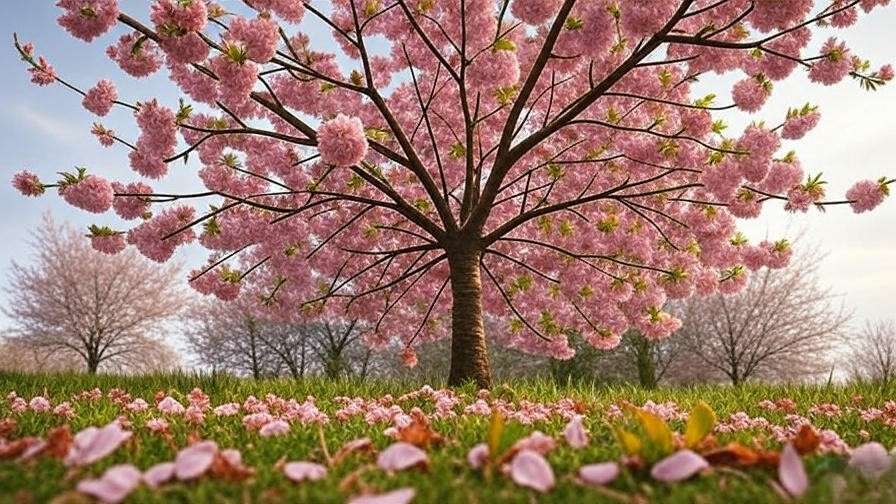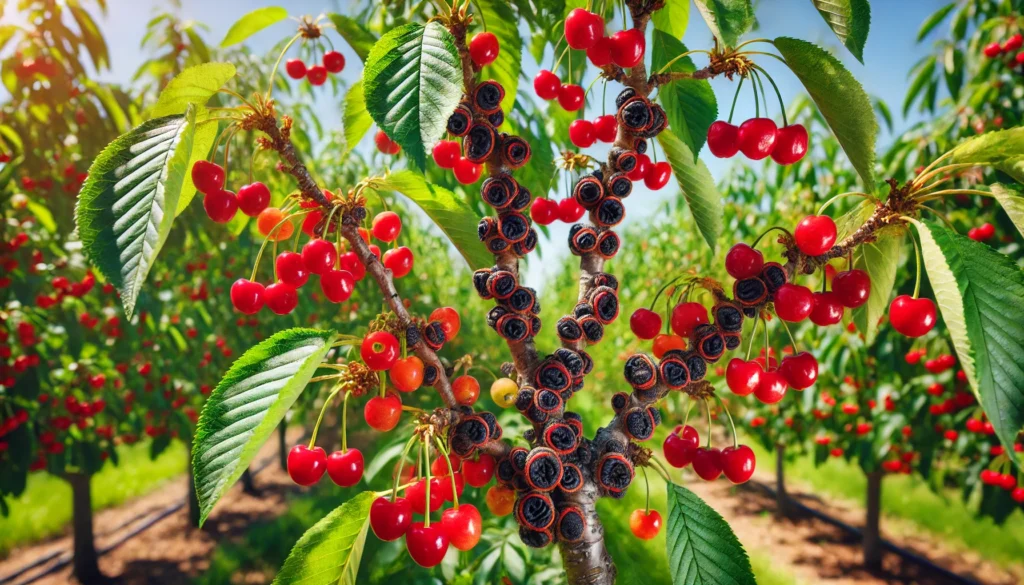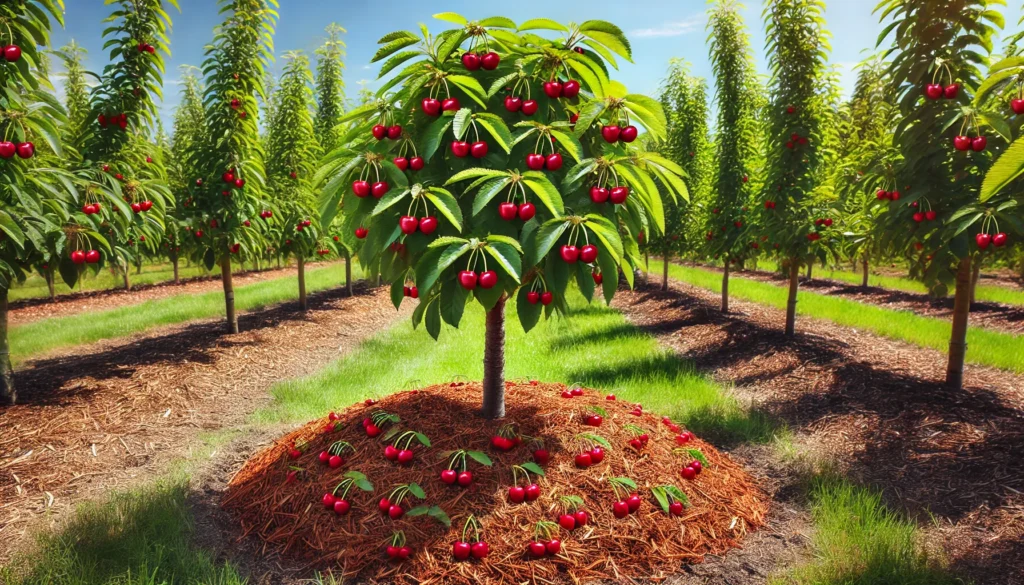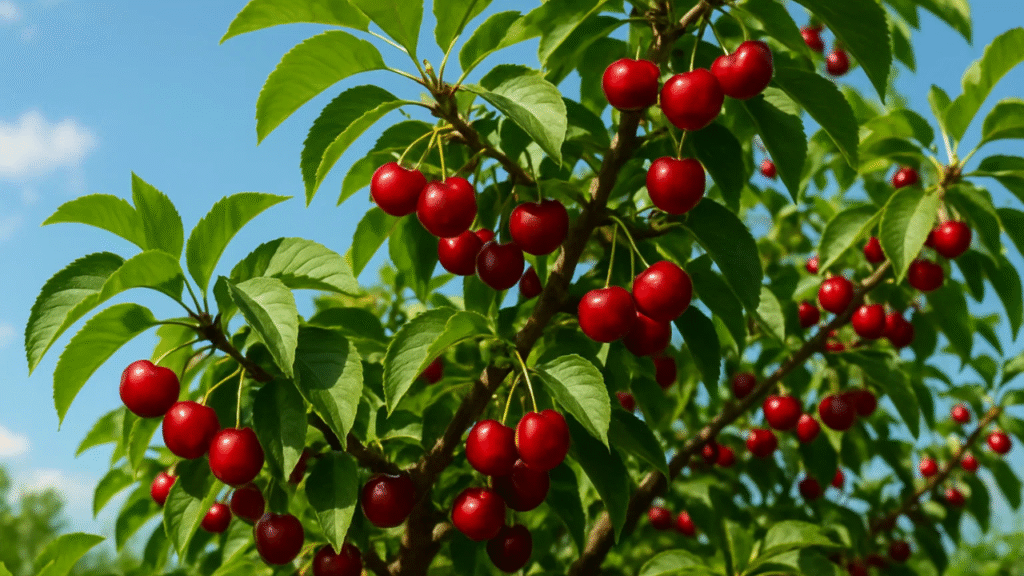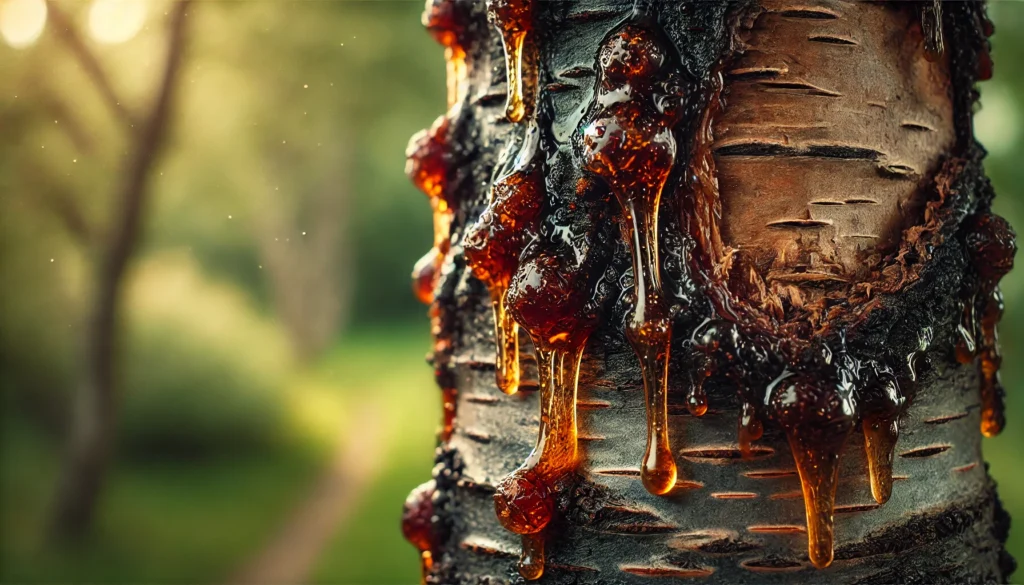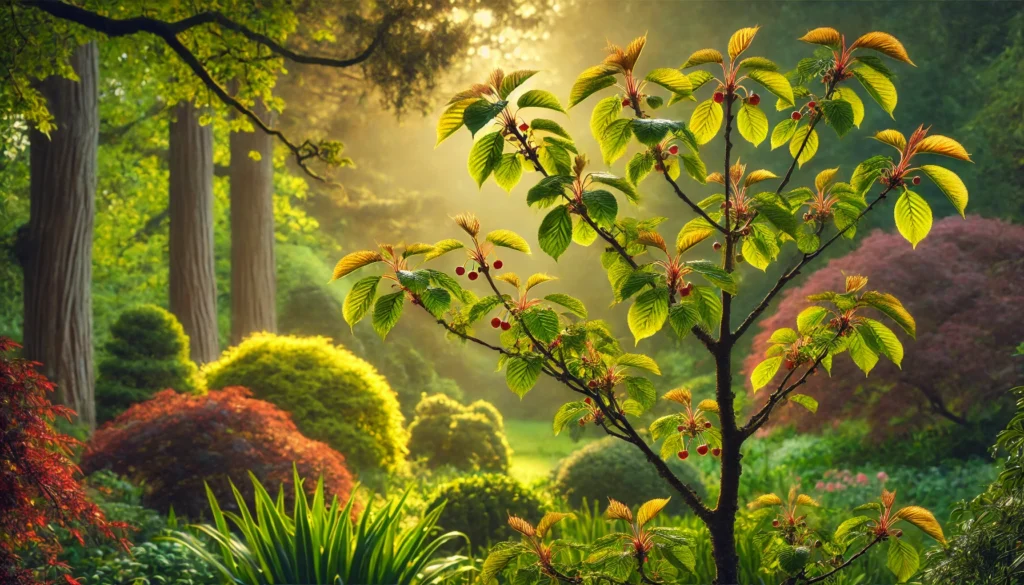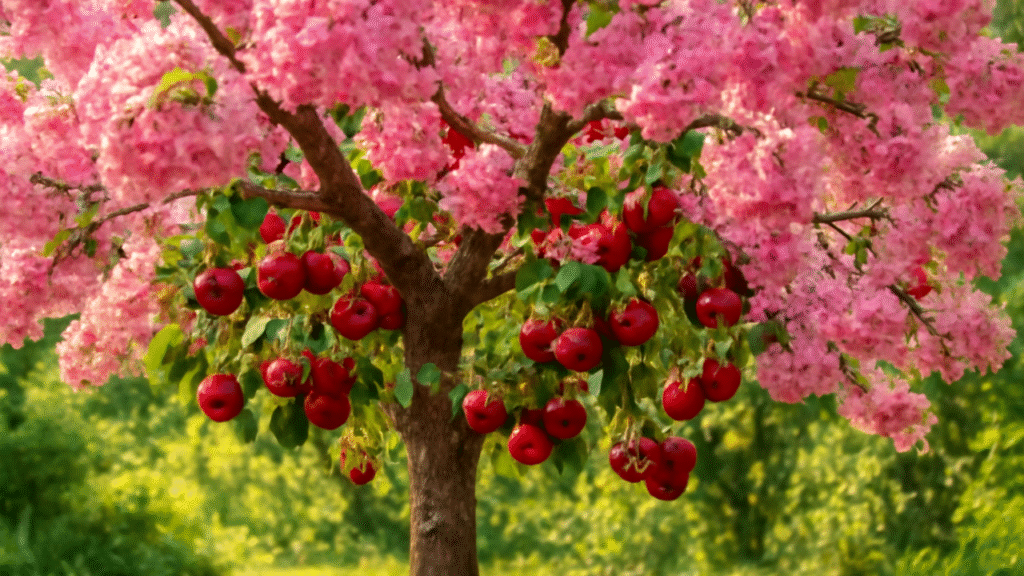Imagine stepping into your backyard to see your cherry tree bursting with lush, sturdy branches, heavy with vibrant, juicy cherries. 🍒 This dream can become reality with the right care! Learning how to encourage strong branch growth in your cherry tree is the key to unlocking a thriving harvest and a healthy, long-lived tree. Whether you’re a novice gardener or a seasoned grower, strong branches are the backbone of a productive cherry tree, supporting abundant fruit and resisting disease. Did you know proper pruning can boost cherry yields by up to 30%? In this comprehensive guide, we’ll share expert-backed techniques, from pruning to nutrition, to help your cherry tree flourish. Let’s dive in and grow a masterpiece! 🌿
Why Strong Branch Growth Matters for Cherry Trees 🌳
The Role of Branches in Tree Health and Fruit Production
Branches are the lifeline of your cherry tree. They support photosynthesis, channeling energy to produce those sweet or tart cherries you love. Strong branches ensure efficient nutrient distribution from roots to leaves, fostering vibrant growth. Weak or spindly branches, however, can lead to poor fruit quality, disease vulnerability, and even structural failure under heavy fruit loads. By prioritizing branch strength, you’re investing in your tree’s overall health and productivity.
Benefits of Robust Branch Growth
- Structural Integrity: Sturdy branches can support heavy cherry crops without breaking.
- Improved Air Circulation: Well-spaced branches allow better airflow, reducing fungal diseases like powdery mildew.
- Enhanced Sunlight Exposure: Strong, well-positioned branches maximize light capture, improving fruit size and flavor.
- Long-Term Vitality: Healthy branches contribute to a tree’s longevity, ensuring decades of beauty and harvests.
Understanding Your Cherry Tree’s Growth Patterns 🌱
Types of Cherry Trees and Their Growth Habits
Cherry trees come in two main types: sweet (e.g., Bing, Stella) and sour (e.g., Montmorency). Sweet cherries often grow taller, reaching 20–30 feet, while sour varieties are typically smaller, around 15–20 feet. Dwarf varieties, like ‘Compact Stella,’ are ideal for smaller gardens, growing 8–12 feet. Understanding your tree’s growth habit is crucial—dwarf trees require less aggressive pruning, while standard trees need more structural training to manage their size.
Key Factors Influencing Branch Growth
Several factors shape how your cherry tree’s branches develop:
- Soil Quality: Cherry trees thrive in well-draining, loamy soil with a pH of 6.0–6.8.
- Sunlight: At least 6–8 hours of direct sunlight daily promotes vigorous branch growth.
- Water: Consistent moisture supports cell expansion in new branches.
- Tree Age: Young trees focus on vegetative growth, while mature trees prioritize fruit production.
- Climate: Cherry trees prefer temperate climates, with cold winters to break dormancy and warm summers for growth.
Essential Techniques to Encourage Strong Branch Growth 🌼
1. Proper Pruning for Optimal Growth ✂️
Pruning is the cornerstone of strong branch development. It shapes the tree, removes weak growth, and stimulates healthy new branches.
When and How to Prune
The best time to prune cherry trees is late winter or early spring, before buds swell but after the risk of hard frost. This timing minimizes stress and encourages vigorous spring growth. You’ll need clean, sharp pruning shears, loppers, and a pruning saw for larger branches. Always sterilize tools with rubbing alcohol to prevent disease spread.
Pruning Techniques for Cherry Trees
- Remove Dead or Damaged Branches: Cut away any dead, broken, or diseased wood to redirect energy to healthy growth.
- Thin Crossing Branches: Eliminate branches that rub or overlap to improve airflow and reduce disease risk.
- Encourage Outward Growth: Make cuts just above outward-facing buds to promote a wide, open canopy.
- Avoid Over-Pruning: Remove no more than 25% of the canopy in a single season to prevent stress.
Expert Tip
Horticulturist Dr. Emily Carter notes, “Pruning is like sculpting—every cut shapes your tree’s future. Focus on creating a balanced structure to support heavy fruit loads.” For young trees, aim for a central leader or open-center shape, depending on the variety.
2. Providing Adequate Nutrition 🍎
Healthy branches need proper nutrition. A well-fed cherry tree produces thicker, stronger growth.
Soil Testing and Fertilization
Start with a soil test to check pH and nutrient levels. Cherry trees prefer a slightly acidic pH (6.0–6.8). Based on test results, apply a balanced fertilizer, such as 10-10-10 NPK, in early spring. For a 5-year-old tree, use 1–2 pounds of fertilizer, spread evenly around the drip line. Avoid applying fertilizer directly against the trunk to prevent root burn.
Organic vs. Synthetic Options
Organic options like compost, aged manure, or fish emulsion enrich soil gradually and improve microbial activity. Synthetic fertilizers offer quick nutrient boosts but should be used sparingly to avoid over-feeding. A mix of both—compost in fall and a light synthetic application in spring—often yields the best results.
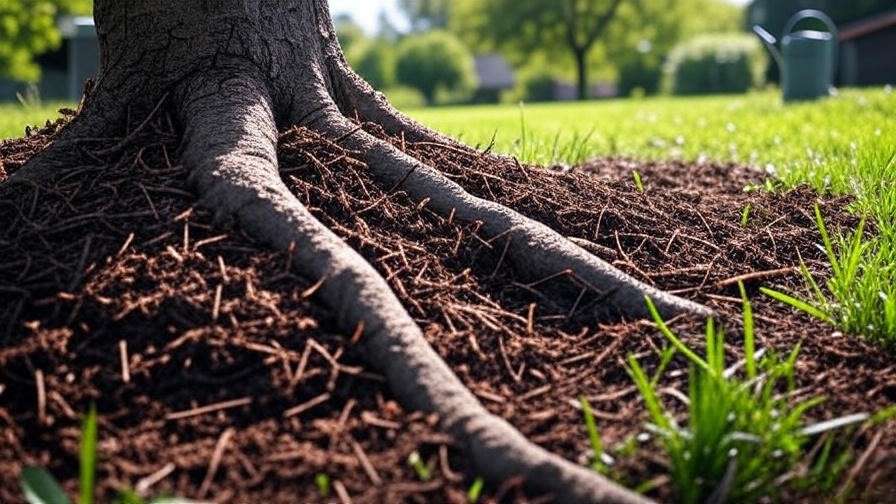
3. Watering Wisely 💧
Water is critical for branch development, as it supports cell expansion and nutrient transport.
Watering Schedules for Cherry Trees
Young cherry trees need deep watering (1–2 inches per week) to establish roots and encourage branch growth. Mature trees require less frequent but deeper watering, especially during dry spells. Use a soaker hose or drip irrigation to deliver water slowly to the root zone. Adjust based on rainfall and season—reduce watering in fall to prepare for dormancy.
Mulching for Moisture Retention
Apply a 2–4-inch layer of organic mulch (e.g., wood chips, straw, or bark) around the base of the tree, keeping it 6 inches from the trunk to prevent rot. Mulch conserves moisture, regulates soil temperature, and suppresses weeds, all of which support healthy branch growth.
4. Training Young Branches for Strength 🏋️♂️
Training young branches sets the foundation for a strong, productive tree.
Using Supports and Ties
For young trees, use stakes or soft ties to guide branches to optimal angles (45–60 degrees from the trunk). This angle promotes strength and fruit-bearing capacity. Check ties regularly to ensure they’re not cutting into the bark as the tree grows.
Avoiding Common Training Mistakes
- Overly Tight Ties: These can girdle branches, restricting growth.
- Improper Angles: Branches too vertical are prone to breaking; those too horizontal may grow weakly.
- Neglecting Adjustments: Revisit training annually to adapt to the tree’s growth.
- 5. Managing Pests and Diseases 🐞
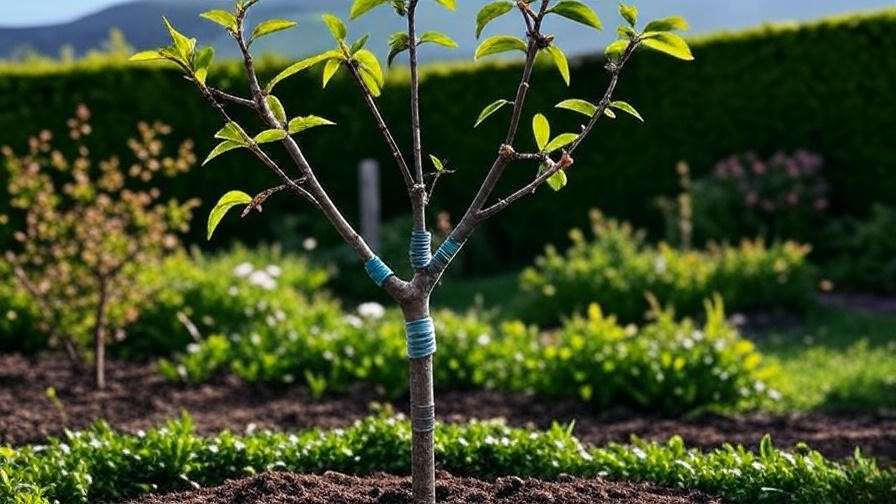
Healthy branches are less susceptible to pests and diseases, but vigilance is key.
Common Threats to Branch Health
- Aphids: These sap-sucking insects weaken new growth. Look for curled leaves or sticky residue.
- Borers: Larvae tunnel into branches, causing dieback. Check for small holes or sawdust-like frass.
- Fungal Diseases: Powdery mildew or brown rot can stunt branch growth. Watch for white coatings or discolored bark.
Preventative and Treatment Measures
- Organic Controls: Spray neem oil or insecticidal soap for aphids. Introduce beneficial insects like ladybugs.
- Cultural Practices: Improve airflow through pruning and remove fallen leaves to reduce fungal spores.
- Regular Inspections: Check branches monthly for signs of trouble, especially in spring and summer.
Seasonal Care for Sustained Branch Growth 📅
Maintaining strong branch growth in your cherry tree requires adapting your care routine to each season. By aligning your efforts with the tree’s natural growth cycle, you’ll promote robust branches year-round. Here’s how to care for your cherry tree through spring, summer, fall, and winter. 🌿
Spring: Kickstarting Growth 🌸
Spring is the season of renewal, when cherry trees burst into growth after winter dormancy. This is the ideal time to set the stage for strong branches.
- Pruning: Perform major pruning in late winter to early spring, before buds break. Focus on shaping the tree and removing any winter-damaged branches. For young trees, establish a strong scaffold structure with 3–5 well-spaced branches.
- Fertilizing: Apply a balanced fertilizer (e.g., 10-10-10 NPK) or compost around the drip line to fuel new growth. A soil test can guide precise nutrient needs.
- Monitoring: Check for early signs of pests like aphids or fungal issues as new shoots emerge. Spray neem oil preventatively if needed.
- Watering: Resume regular watering as temperatures rise, ensuring 1–2 inches per week for young trees.
Summer: Supporting Active Growth ☀️
Summer is when your cherry tree’s branches grow most actively, supporting leaves, flowers, and developing fruit.
- Watering: Increase watering during hot, dry periods, aiming for deep irrigation to reach the root zone. A soaker hose works well to deliver consistent moisture.
- Mulching: Refresh mulch to a 2–4-inch depth to retain moisture and keep roots cool. Avoid piling mulch against the trunk to prevent rot.
- Protecting from Sunscald: Young branches are vulnerable to sunscald, especially on hot days. Wrap trunks with tree wrap or paint with diluted white latex paint to reflect sunlight.
- Pest Management: Inspect for borers or aphids weekly. Remove affected branches promptly and apply organic controls as needed.
Fall: Preparing for Dormancy 🍂
As growth slows, fall care focuses on strengthening branches for winter and setting up for next spring.
- Light Pruning: Remove any weak or damaged growth to reduce winter breakage risks. Avoid heavy pruning, as it can stimulate late growth vulnerable to frost.
- Watering Reduction: Gradually reduce watering as the tree enters dormancy, but ensure the soil doesn’t dry out completely.
- Clean-Up: Rake fallen leaves and debris to prevent fungal spores from overwintering. This reduces disease pressure on branches come spring.
- Fertilizing: Apply a layer of compost or aged manure to enrich the soil for next season’s growth.
Winter: Protecting Branches ❄️
Winter is a time of rest, but protecting branches from cold damage is crucial.
- Wrapping Young Branches: Use burlap or tree wrap to shield young branches from frost cracks or rodent damage. Focus on trees under 5 years old.
- Checking Supports: Ensure stakes and ties are secure but not constricting. Remove any ties that may girdle growing branches.
- Avoiding Pruning: Refrain from pruning during winter, as cuts heal slowly in cold weather, increasing disease risk.
Advanced Tips for Maximizing Branch Strength 🚀
For gardeners looking to take their cherry tree care to the next level, these advanced techniques can further enhance branch growth and tree vigor.
Grafting for Stronger Branches
Grafting involves attaching a scion (a cutting from a desired cherry variety) to a rootstock to improve growth traits. For example, grafting a dwarf variety like ‘Lapins’ onto a hardy rootstock can enhance branch strength and disease resistance. Consult a local nursery or extension service for compatible rootstocks and grafting workshops. Grafting is best done in late winter or early spring.
Using Growth Regulators
Growth regulators, such as gibberellic acid, can stimulate branch elongation in some cases, but they must be used cautiously. Always follow label instructions and consult a horticulturist, as overuse can weaken branches or disrupt fruit production. For most home gardeners, cultural practices like pruning and fertilizing are sufficient.
Companion Planting
Planting companions like marigolds or garlic near your cherry tree can deter pests like aphids, reducing stress on branches. Avoid planting nutrient-hungry crops like corn or sunflowers nearby, as they compete for resources. Nasturtiums are another great companion, attracting beneficial insects that control pests.

Common Mistakes to Avoid When Encouraging Branch Growth 🙅♂️
Even experienced gardeners can make errors that hinder branch development. Avoid these pitfalls:
- Over-Pruning: Removing too much growth stresses the tree, reducing vigor. Stick to the 25% rule—never remove more than a quarter of the canopy in one season.
- Ignoring Soil Health: Neglecting soil tests or over-fertilizing can lead to nutrient imbalances, weakening branches.
- Improper Watering: Overwatering causes root rot, while underwatering stunts growth. Aim for consistent, deep irrigation.
- Neglecting Pests: Delaying pest or disease treatment can damage branches irreversibly. Regular inspections are key.
- Poor Training: Failing to train young branches to proper angles can result in weak, overcrowded growth.
Real-Life Success Stories 🌟
Jane, a home gardener in Oregon, transformed her struggling cherry tree by following these techniques. “My Montmorency was producing tiny, sparse cherries,” she shares. “After proper pruning and adding compost, the branches grew thicker, and my yield doubled in two years!” Similarly, a Michigan State University extension program reported that growers who adopted regular soil testing and mulching saw a 20% increase in branch vigor and fruit quality. These stories highlight the power of consistent, informed care.
FAQs About Cherry Tree Branch Growth ❓
How often should I prune my cherry tree?
Prune annually in late winter or early spring to shape the tree and remove weak growth. Light summer pruning can address damaged branches.
Can I encourage branch growth in an older cherry tree?
Yes! Focus on light pruning, balanced fertilization, and pest management. Older trees may grow more slowly, but consistent care improves branch health.
What’s the best fertilizer for cherry trees?
A balanced 10-10-10 NPK fertilizer or organic compost works well. Apply based on soil test results to avoid over-fertilizing.
How do I know if my tree’s branches are healthy?
Healthy branches are firm, with smooth bark and vibrant leaves. Look for signs of trouble like wilting, discoloration, or small holes.
Can overwatering harm branch growth?
Yes, overwatering leads to root rot, reducing nutrient uptake and weakening branches. Ensure well-draining soil and moderate watering.
Conclusion
Encouraging strong branch growth in your cherry tree is a rewarding journey that leads to healthier trees, abundant harvests, and a stunning garden centerpiece. 🌳 By mastering pruning, providing proper nutrition, watering wisely, training young branches, and managing pests, you’ll set your tree up for success. Start implementing these expert tips today, and watch your cherry tree thrive! Have a success story or question? Share it in the comments or reach out for personalized advice. Know a fellow gardener? Share this guide to help their cherry trees flourish! 🍒

